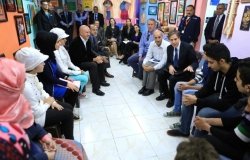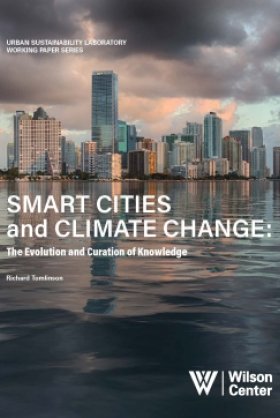Youth and The City: Comparative Perspectives on Urban Space, Class, and Gender in Recife (Brazil), Hanoi (Vietnam), and Lusaka (Zambia)
Karen Tranberg Hansen, Professor of Anthropology, Department of Anthropology, Northwestern University. Wilson Center Scholar. Anne Line Dalsgård, Associate Professor, Institute of Anthropology, Aarhus University.Karen Valentin, Assistant Professor, Danish University of Education.Discussant: Pamela Reynolds, Professor of Anthropology, Johns Hopkins University.
Overview
Youth, most frequently defined as those between the ages of 15 and 24, comprise a major part of the urban population in rapidly growing cities of the developing world. By 2030, it is estimated that 60 percent of urban dwellers worldwide will be under the age of eighteen. Such rapid urbanization processes pose serious challenges to local governments and urban managers in the developing world, signifying the need to expand attention to youth cohorts. On April 27, 2006 the Comparative Urban Studies Project hosted a seminar to discuss youth groups in three rapidly growing cities: Recife (Brazil), Hanoi (Vietnam), and Lusaka (Zambia).
Karen Tranberg Hansen, Professor of Anthropology at Northwestern University and Wilson Center Fellow, gave a brief overview of the comparative research project on youth and the city funded by the Council for Development Research of the Danish International Development Agency (DANIDA) and conducted between 2001 and 2005. The interdisciplinary research team included three anthropologists, a geographer, an education specialist, and a media studies scholar as well as local collaborators in the three cities. Hansen pointed out that although the three cities examined in the study have different histories, they share recent major urban growth. Socio-economically and culturally heterogeneous, they each confront income inequality and diverse combinations of ethnic and racial distinctions. The three anthropologists began the study by conducting household surveys across class to examine the resources available to youth, then they observed where youth activities take place, what type of interactions young people have, and how they use the urban environment.
Karen Valentin, Assistant Professor at the Danish University of Education, described the situation of urban youth in Hanoi. She pointed out that the physical organization of the city is not only influenced by political power, but by the urban youth in Hanoi. Young people aged 14-25 are currently the largest demographic segment of the population, constituting 24.5% of the total population in Vietnam. The Vietnamese term for "youth", thanh nien, was originally designated only to denote young men, but in contemporary society, it encompasses both genders. Current notions of youth defined by research informants are linked to increasing responsibilities such as preparing for a professional career, getting married, financial responsibilities, observing the law, and as citizens, contributing to the development of the nation. According to Valentin, certain places in the city are allocated to young people because they are considered proper and safe for them. Controlling young people's access to particular places in the city implies a politicalization of space in which both guardians and the state are central actors. Valentin addressed the important role played by the Ho Chi Minh Communist Youth Union founded in 1931, which not only serves to occupy young people's spare time, but also aims to steer them away from ‘dangerous' places and activities in the city and establishes new, morally legitimate space for them. It is still under direct control of the Communist Party and is considered "the socialist school for youth". The Youth Union is an example of a state institution that is attempting to regulate young people's access to and use of public spaces while also providing a shared sense of identity. Valentin ended her talk by emphasizing youth as urban citizens with rights to the city. They are social actors that are embedded into generational hierarchies and wider structural conditions.
Anne Line Dalsgård, Associate Professor at the Institute of Anthropology, Aarhus University, focused her talk on urban youth, mainly young men from low-income areas, in Recife. Dalsgård detailed her research on youth in two low-income neighborhoods, Santa Barbara and Vietnã, to illustrate how young men in particular find themselves without a place in the public space of the city. Within their own neighborhoods, they are immediately recognized and have family and friends. Once they leave these neighborhoods, they are stigmatized, avoided, or directly excluded from public engagement. To the outside world they are dangerous because they are young and they belong to the periphery of the city. Dalsgård further explained that the term ‘youth' has several meanings in Brazil as each social class assigns specific roles and responsibilities to its youngsters. In poorer families youth are recognized as adults earlier on in life and have to find ways of providing financial assistance to their families. In middle income households young people are encouraged to focus on school and education. While middle class youth try to follow a cultural script for the passage to adulthood, young people from low-income groups move along a variety of paths. Dalsgård noted that Recife has one of the highest rates of death due to firearms among young men between 15 and 24 in cities of Brazil. The majority of these victims come from the low-income sector. This further stigmatizes the urban youth as ‘dangerous' members of society who inflict violence onto the streets of their cities. Dalsgård explained how this danger ascribed to the youth is closely linked to their marginal position in the Brazilian economy. Many young men do feel responsible for their own lives and the survival of their families, but they do not have the means to act accordingly. In her study, Dalsgård found that irresponsibility is not so much a chosen attitude as it is the attribute of an economically marginalized person. Young people from Recife's poorer areas suffer from unemployment, lack of education, and job training. Finally, Dalsgård ended her talk by describing a park in Santa Barbara that was constructed in response to the lack of public space in the neighborhood. The municipality had given priority to security when it planned the park. It was open, without shade, uncomfortable and unwelcoming. Not surprisingly the park was not a popular place among the youth. It reconfirmed the negative image of youth from the periphery instead of giving them a place to gather and socialize. For Dalsgård this exemplified the way in which urban youth have very restricted access to places within the city, limiting their rights of passage and of citizenship.
Karen Tranberg Hansen described her research on urban youth in Lusaka. According to 2004 UNDP projections, young people below 25 years of age comprise 64% of Zambia's total population (about 11 million). Lusaka, the capital of Zambia, has an estimated population of 2.5 million. Zambia is near the bottom of the list of low human development countries, with very low performance on standard indicators of development. Youth in Zambia is defined as the age group between 12 or 15, and 35 years of age. Young people and adults generally agree that the chief meaning of youth is dependency. In order to explain her observations in three different residential areas of Lusaka, Hansen described three different trajectories towards adulthood: getting stuck, getting by, and getting on. Young people living in the compounds with crowded households, few means of income, and a lack of education easily fall into "getting stuck". Life in the compound is governed by unemployment and hunger. "Getting by" is the ability of young people to navigate their way through a range of educational courses, occasional jobs, and self-employment, struggling to not slide down and become stuck in the compound. "Getting on" has to do with young people from higher-income households that are able to take advantage of networks and contacts to craftwork options. They also have the means, because of well-placed parents or guardians, to advance their careers by adding training that may allow them to take advantage of new occupational opportunities. Hansen concluded that employment reaches the heart of the urban youth predicament in Zambia. Between 1992 and 1999, formal employment declined from 17 to 11%. Zambia's Poverty Reduction Strategy Program (PRSP), a structural adjustment program initiated by the World Bank, makes no mention of youth even though they constitute an extraordinarily relevant category as their livelihoods cut across the specific sectors on which Zambia's PRSP focuses: agriculture, tourism, health, and education. The PRSP focuses on the promotion of investment, trade, and the development of small and medium enterprises. Such enterprises are hailed as development strategies in the new Technical Education, Vocational and Entrepreneurship Training Policy (TEVET). It is an example of a youth oriented policy, specifically revolving around micro-enterprise with clearly targeted beneficiaries according to Hansen: young women and men out of school from Grades 7 through 12. Hansen warns that entrepreneurship and micro-enterprises in the informal economy are not going to solve the problems of unemployment. Age and gender based hierarchies within the informal economy restrict young people's access, propelling them into casual work and low-grade jobs that curtail upward mobility and the acquisition of the skills and qualifications required for job promotion.
While recognizing the different challenges facing urban youth in each of the three studies, discussant Pamela Reynolds, Professor of Anthropology at Johns Hopkins University, posed questions that draw common threads to join the cases in further examination of the role, opportunities, and constraints placed on youth. First, she asked, are the state and society obliged to urban youth or have they turned from responsibility? Second, what has changed? Youth have always been expendable, observed Reynolds. With longer life expectancy and increasing populations, youth are exploited in service economies. What kind of governance serves the young, she asked. Third, how are young people without resources or status incorporated into the larger society? Young people were useful for land, armies and slavery, argued Reynolds. Today they face gangs, drugs, disease and prison as a way to adulthood. Finally, Reynolds identified three concerns: the need to rephrase minimal state and individual investment in youth; to manage the generational divide; and, to appreciate the role of ethnography in bringing the voices of individuals and greater detail to light. In her final remarks, Reynolds challenged the role of anthropologists. There is a fine line between describing real life issues in a meaningful and honest way and translating findings into a language for policymakers, she concluded.
Hosted By

Urban Sustainability Laboratory
Since 1991, the Urban Sustainability Laboratory has advanced solutions to urban challenges—such as poverty, exclusion, insecurity, and environmental degradation—by promoting evidence-based research to support sustainable, equitable and peaceful cities. Read more
Thank you for your interest in this event. Please send any feedback or questions to our Events staff.









